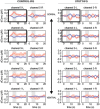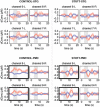Hemodynamics of speech production: An fNIRS investigation of children who stutter
- PMID: 28642548
- PMCID: PMC5481456
- DOI: 10.1038/s41598-017-04357-6
Hemodynamics of speech production: An fNIRS investigation of children who stutter
Abstract
Stuttering affects nearly 1% of the population worldwide and often has life-altering negative consequences, including poorer mental health and emotional well-being, and reduced educational and employment achievements. Over two decades of neuroimaging research reveals clear anatomical and physiological differences in the speech neural networks of adults who stutter. However, there have been few neurophysiological investigations of speech production in children who stutter. Using functional near-infrared spectroscopy (fNIRS), we examined hemodynamic responses over neural regions integral to fluent speech production including inferior frontal gyrus, premotor cortex, and superior temporal gyrus during a picture description task. Thirty-two children (16 stuttering and 16 controls) aged 7-11 years participated in the study. We found distinctly different speech-related hemodynamic responses in the group of children who stutter compared to the control group. Whereas controls showed significant activation over left dorsal inferior frontal gyrus and left premotor cortex, children who stutter exhibited deactivation over these left hemisphere regions. This investigation of neural activation during natural, connected speech production in children who stutter demonstrates that in childhood stuttering, atypical functional organization for speech production is present and suggests promise for the use of fNIRS during natural speech production in future research with typical and atypical child populations.
Conflict of interest statement
The authors declare that they have no competing interests.
Figures





References
Publication types
MeSH terms
Substances
Grants and funding
LinkOut - more resources
Full Text Sources
Other Literature Sources
Medical

